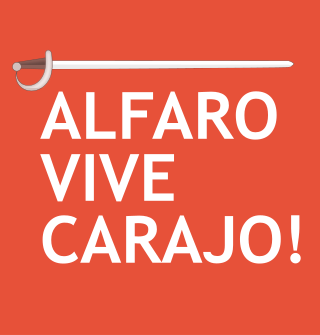The History of Ecuador covers human habitation in the region reaching back 8,000 years.

Lucio Edwin Gutiérrez Borbúa served as 43rd President of Ecuador from 15 January 2003 to 20 April 2005.

Club Sport Emelec is an Ecuadorian sports club based in Guayaquil that is best known for their professional football team. The football team plays in the Ecuadorian Serie A, the highest level of professional football in the country.

Jorge Jamil Mahuad Witt is an Ecuadorian lawyer, academic and former politician. He was the forty-first president of Ecuador from 10 August 1998 to 21 January 2000.

Álvaro Fernando Noboa Pontón is an Ecuadorian businessman and politician. He is the father of the incumbent president, Daniel Noboa.

¡Alfaro Vive, Carajo! (AVC), another name for the Fuerzas Armadas Populares Eloy Alfaro, was a clandestine left-wing group in Ecuador, founded in 1982 and named after popular government leader and general Eloy Alfaro. The group was labeled as a terrorist organization by the Ecuadorian state during the period of the former president León Febres Cordero. It existed between 1983 and 1991, when it carried out various armed actions and criminal acts in Ecuador, with Colombian (M-19) and Nicaraguan influence. The group was initially formed sometime in the 1970s, but was not active militarily for the first few years of the 80's.

Lenín Boltaire Moreno Garcés is an Ecuadorian politician who served as the 46th president of Ecuador, from 2017 to 2021. Moreno was vice president from 2007 to 2013, serving under President Rafael Correa.

The Central Bank of Ecuador is the central bank of the country, and an institution of the Executive Function, which has institutional, administrative, financial, and technical autonomy. It is in charge of executing the monetary policy established by the Monetary Policy and Regulation Board of Ecuador, which has been the institution's highest governing body since October 2021.
Banking in Ecuador has a long history. At the time of the dissolution of Gran Colombia and its formation as a republic, Ecuador's economy was generally not monetized; gold and silver coins were circulated, and were brought into common use by successive currency laws. Little by little, with the growth of the nation, Ecuadorian banking also grew and was particularly centered on the city of Guayaquil. After the Liberal Revolution came a period called the Banking Plutocracy that was dominated by private banking, especially by the Commercial and Agricultural Bank of Guayaquil. This period ended with the July Revolution of 1925.
The 1998–99 Ecuador economic crisis was a period of economic instability that resulted from a combined inflationary-currency crisis, financial crisis, fiscal crisis, and sovereign debt crisis. Severe inflation and devaluation of the sucre led to President Jamil Mahuad announcing on January 9, 2000 that the U.S. dollar would be adopted as the national currency. Poor economic conditions and subsequent protests against the government resulted in the 2000 Ecuadoran coup d’état in which Jamil Mahuad was forced to resign and was replaced by his Vice President, Gustavo Noboa.

Marcel Jacobo Laniado de Wind was an Ecuadorian agricultural engineer and banker who held a number of important public and private positions in Ecuador. He was a humanist, and a public figure in Ecuador for his efforts to improve the country.

Canal Uno was an Ecuadorian television network owned by the Group Rivas operated RELAD S.A., in the city of Guayaquil and Canal Uno S.A., in the city of Quito. Since its start in broadcasting on November 6, 1992, as CRE Televisión, April 18, 1994, as SíTV and May 6, 2002, the channel has become one of the largest chains of Ecuador.

Guillermo Alberto Santiago Lasso Mendoza is an Ecuadorian businessman, banker and politician who served as the 47th president of Ecuador from 2021 to 2023. He was the country's first conservative president in nearly two decades, marking a shift in the country's electorate.

Juan Falconi Puig is a doctor in law, a university professor, a columnist as well as a politician. In 2013 he was appointed Ambassador of Ecuador to the United Kingdom (12). In 2015 he was appointed to represent Ecuador as Permanent Ambassador to the World Trade Organization, headquartered in Geneva Switzerland.

TC Televisión is a state-owned television network in Ecuador. The network was founded in 1969 and was commercially funded for many years until 2011 when The Isaias Group went into a lawsuit and was sold to a state government unit, Since then the channel been owned by SERTVSA.

Although China's economic influence is growing rapidly throughout Latin America, it is perhaps most evident in Ecuador where it enjoys a near-monopoly of crude exports. Critics of Ecuadorian President Rafael Correa say that the Chinese influence has gone too far and threatens national sovereignty while indigenous peoples' rights and biodiversity could be severely harmed because of Ecuador's oil commitments to China.

Corruption in Ecuador is a serious problem. In 2014, the U.S. Department of State cited Ecuador's corruption as a key human-rights problem. According to Freedom House, "Ecuador has long been racked by corruption", and the weak judicial oversight and investigative resources perpetuate a culture of impunity.
The Isaias Group is an Ecuadorian pan regional entrepreneurial conglomerate with an interest in a vast range of sectors, the key industries being media, telecommunications and banking. The group, which owns more than 100 companies, is owned by three brothers, Roberto Isaias, William Isaias and Estefano Isaias. For decades, the group owned companies across several industries, including commercial, real estate, agroindustry, oil, and media. The three brothers led the group's growth and diversification since the 1980s.
Constituent Mandate 13 was an amendment to the Ecuadorian Constitution passed by the Ecuadorian government in 2007. The purpose of the mandate was to seize properties owned by The Isaias Group for the stated purpose of reimbursing former depositors of Filanbanco SA, a bank that the Ecuadorian government acquired which then went bankrupt during the government's ownership of it.














